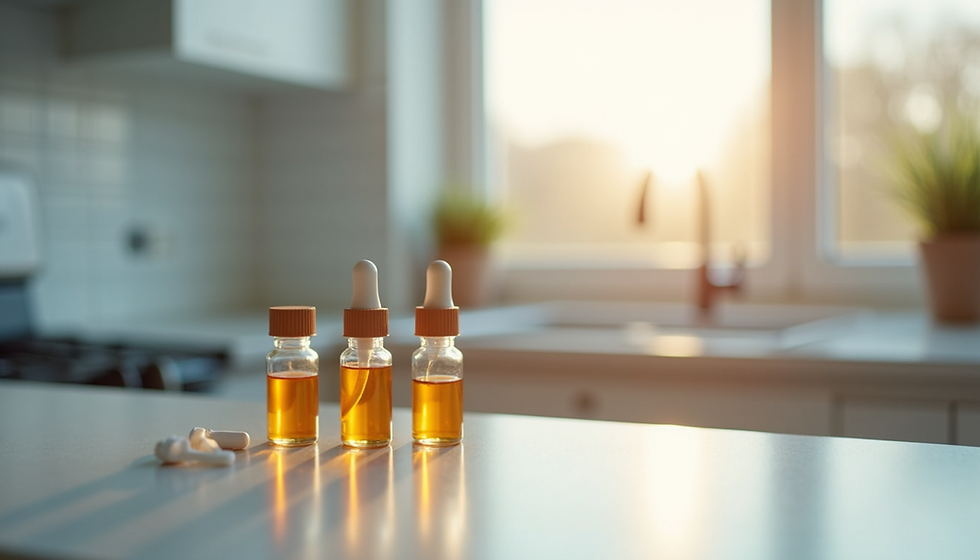Perimenopause: A Natural Transition and a Time to Reconnect with Yourself
- Kathy Roberts
- Aug 10
- 4 min read
Updated: Oct 13
Perimenopause is a completely natural, yet often bewildering, transition. It’s one of the most searched women’s health topics today, which says so much about how many of us are quietly seeking understanding and reassurance.
More women are experiencing stronger or earlier symptoms than previous generations, and this isn't just a coincidence.
Modern life places greater demands on our bodies and minds. We juggle careers, families and responsibilities, often with little rest. Chronic stress, environmental toxins, processed foods, and disrupted sleep can all add pressure to the delicate hormonal balance that guides this phase of life.
As a result, the body can struggle to make the gentle adjustments it's designed for. Instead of a smooth transition, many women feel overwhelmed by hot flushes, fatigue, mood changes and loss of confidence.
In my homeopathic practice here in Wiltshire, I meet many women who tell me they just don’t feel like themselves anymore, struggling with weight gain, brain fog, mood swings, hot flushes, anxiety, or restless nights. Others worry about bone health or feel emotionally unsteady, even though they’ve always been resilient.
If this sounds familiar, please know: you’re not alone, and your body isn’t failing you. It’s changing, in a beautifully intelligent way , asking for care, nourishment and a slower rhythm, to guide you into the next phase of life.
This guide blends what I’ve learned as a practitioner with current health insights and the most-searched perimenopause questions. My hope is that it helps you understand what’s happening within your body, and shows how nutrition, movement, rest, and homeopathy can support you in feeling more balanced and energised.
🌸 The Ovaries Step Back
For most of your reproductive life, your ovaries have worked quietly and faithfully, producing oestrogen and orchestrating your monthly cycle. As you approach menopause, ovulation becomes less frequent and oestrogen levels begin to dip.
This isn’t a malfunction, it’s a wise, built-in transition. Your body is gently preparing you for a new rhythm.
🌿 Enter the Adrenals – Your Backup Hormone Factory
Your adrenal glands, which sit above your kidneys, are remarkable. Known mostly for producing stress hormones like cortisol, they also make small amounts of oestrogen and other sex hormones from a substance called DHEA.
When your adrenals are nourished and supported, they can soften the hormonal changes of perimenopause, helping to ease hot flushes, mood changes, and dryness.
However, when stress levels are high and the adrenals are overworked, this delicate system struggles. That’s why slowing down, resting well, and caring for your emotional wellbeing are not luxuries, they’re essential forms of hormone support.
🌼 Fat Cells: More Than Storage
Your fat cells also help produce oestrogen, a weaker type called estrone. When oestrogen drops, the body may try to protect you by holding onto fat, especially around the tummy, hips, or thighs. It’s not a failure of willpower; it’s a survival strategy.
This gentle understanding can transform frustration into compassion for yourself.
💛 Most Searched Symptom: Weight Gain
Weight gain is the top perimenopause concern in the UK. Lower oestrogen alters how your body uses and stores fat, and metabolism naturally slows. Muscle mass decreases, blood sugar regulation changes, and sometimes emotional eating adds another layer.
What helps:
Strength training: builds lean muscle and boosts metabolism.
Balanced, protein-rich meals: stabilise blood sugar.
Stress management: lowers cortisol, a key fat-storing hormone.
🌙 Brain Fog & Memory Changes
If you’ve found yourself walking into a room and forgetting why you’re there, you’re in good company. Oestrogen plays a big role in memory and mental clarity.
What helps:
Stay hydrated.
Include omega-3 foods (salmon, chia, walnuts).
Move your body daily, even a brisk walk improves blood flow to the brain.
Keep your mind engaged: read, learn, create.
🌷 Mood Swings & Anxiety
Fluctuating oestrogen levels can affect serotonin and dopamine, the “feel-good” chemicals in your brain. You may feel more sensitive or reactive than usual.
What helps:
Gentle daily movement.
Mindfulness, deep breathing, journaling.
Connection — with friends, loved ones, or supportive groups.
🍯 Blood Sugar Balance
As oestrogen dips, insulin becomes less efficient. That’s why sugar cravings, energy crashes, and tummy fat can appear.
What helps:
Prioritise movement, especially resistance training.
Eat balanced meals with protein, fibre, and healthy fats.
Avoid skipping meals or relying on caffeine for energy.
🌻 Bone Health
Oestrogen protects your bones, and lower levels can increase the risk of bone loss. The good news is that movement and nutrition make a real difference.
What helps:
Weight-bearing exercise — walking, dancing, or strength work.
Calcium-rich foods — leafy greens, almonds, tahini, dairy if tolerated.
Vitamin D — from sunlight or supplementation. (D3 & K2 together)
🌺 Oestrogen-Rich Foods (Phytoestrogens)
Nature offers gentle oestrogen-like compounds called phytoestrogens:
Flaxseeds
Soy (tofu, tempeh, miso, edamame)
Chickpeas and lentils
Sesame seeds
Red clover tea
💧 Homeopathic Support for Perimenopause
Homeopathy can be a beautiful ally during perimenopause. Remedies are chosen to match your individual pattern of symptoms, not just the diagnosis.
Some examples (always best assessed personally):
Sepia: exhaustion, irritability, wanting to escape or disconnect.
Lachesis: hot flushes, especially at night, and intensity in emotions.
Pulsatilla: tearfulness, comfort cravings, feeling emotionally tender.
Sulphur: heat, restlessness, disturbed sleep.
A one-to-one consultation allows me to find the remedy that fits you — your body, mind, and emotional landscape.
🌞 A Season of Renewal
Perimenopause isn’t the end of vitality, it’s a rebalancing, a reawakening. It invites you to slow down, to listen, and to care for yourself in ways that perhaps weren’t possible before.
When we support the body naturally, through nourishment, movement, rest, and homeopathy — this can become a time of renewed strength and inner confidence.
💛 If you’d like personalised homeopathic support for perimenopause, I’d love to help.






Comments